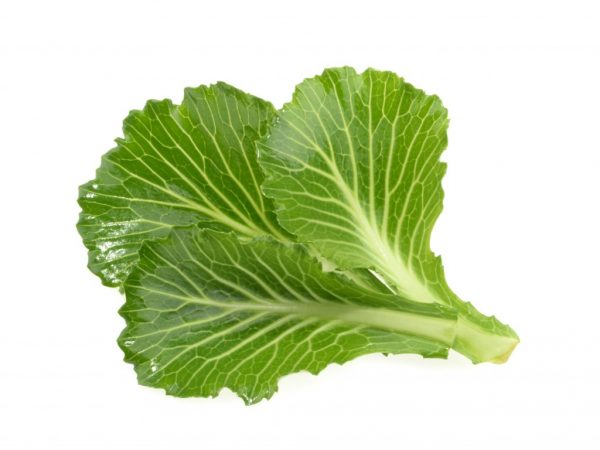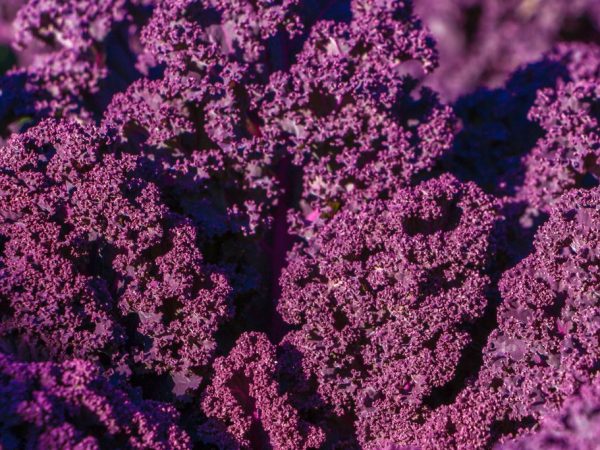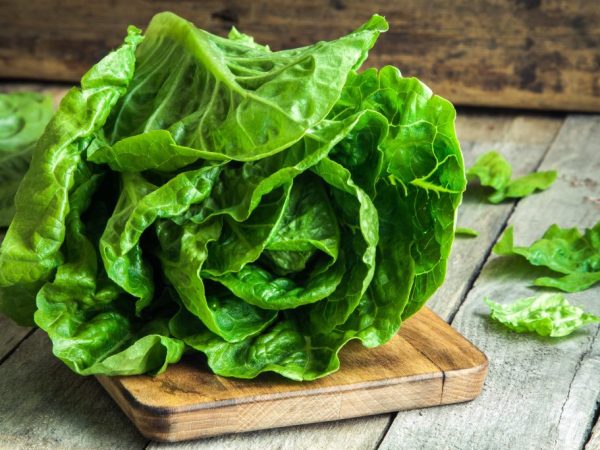Collard greens
Collard greens are popular with gardeners. This variety has many varieties, each of which has its own growing characteristics.

Collard greens
Calais
Kale collard has several names - Gruncol, Brauncol, Bruncol and kale. It is an annual plant.
Mostly kale kale is grown for decorative purposes. It is distinguished by its high frost resistance and the ability to grow in different climatic conditions. Some species are able to withstand temperatures as low as -15 °, others can endure extreme heat - about 30 °.
Only vegetable leaves are used for food. The stems are too hard and tough, so they are discarded.
Depending on the variety, the height of the plant varies from 40 to 90 cm.
Red-leaved feces
Red collard greens are highly decorative. Lacy leaves with purple color. Reaches 50-75 cm in height, withstands a drop in temperature to -15 °.
This plant belongs to mid-season annual varieties. It is grown as an ornamental and fodder crop. Due to its unique vitamin and mineral composition, red cabbage is excellent for dietary nutrition.
With regular use, immunity increases, the body is saturated with all useful components.
Composition:
- trace elements - magnesium, calcium;
- vitamins A, C, K;
- antioxidants.
Growing features
There are two ways to grow red-leaved kale collard greens - seedling and seed.
Seedling method
Seeds are planted in early spring when the heat has stabilized. Seedlings germinate quite successfully at a temperature of 4-5 °. Planting seedlings in the garden bed is carried out later - in late April - early May.
Seed method
It is necessary to plant seeds, as well as seedlings, in soil that has been loosened and fertilized since autumn. The plot is sprinkled with rotted manure or compost - 1 bucket per 1m2. From mineral fertilizers, ash and phosphorus are used (100 g each). After that, the site is dug up, and in the spring it is leveled with a rake.
Seeds of kale variety must be planted at a distance of 50 cm from each other, between rows - 55 cm. Then the planting is watered: seedlings at the root, seedlings are irrigated from a spray bottle.
To speed up the process of germination of seedlings, plantings are covered with transparent film or glass. After 5-6 days, they germinate together. After that, you can remove the shelter and remove the weak shoots.
Care

Taking care of the plant is not difficult
The main care consists in regular watering, loosening the soil, weeding and feeding. You need to water as the soil dries out. 2 days after watering, a soil loosening procedure is carried out.
Top dressing with complex fertilizers is carried out 3 times per season:
- when 2 leaves appear;
- two weeks after the first feeding;
- three weeks after the second.
Harvesting
Leaves are cut throughout the summer season.Some gardeners manage to preserve plantings in the winter, covering them with spruce branches, needles or sawdust. Under the influence of frost, the leaves of plants acquire a rich purple color. In terms of taste, overwintered leaves become even tastier and juicier.
Redbor
Redbor leaf cabbage f1 belongs to the ornamental curly-leaved vegetable varieties. Green cabbage of this variety reaches 1-1.5 m in height. The leaves are large, purple in color, collected in a rosette. In appearance, the Redbor variety resembles a palm tree.
It is a two year old hybrid that begins to yield in the second year after planting.
Redbor kale has a rich vitamin composition:
- vitamin C;
- sugar;
- vegetable protein;
- carotene.
According to the characteristics, Redbor is readily used in cooking for the preparation of various salads and as decorations for various dishes.
Landing rules
The dimensions of the plant depend on the time of planting the seeds. Before planting them, the soil is fertilized with organic matter, dug up and well watered. The cultivation of this culture is carried out in a sunny area.
Change f1 redborne should be sown in the last decade of March at a distance of 2-2.5 m. Several seeds are placed in each hole, and after germination, weak seedlings are removed.
When the green seedlings grow up and get stronger (after about a month), they are transplanted to a permanent place.
Further care is no different from caring for other varieties of kale. This is a winter-hardy plant, so it easily tolerates severe frosts and snows. After wintering, green cabbage becomes more juicy and sweeter.
Reflex

The vegetable contains many vitamins
Leafy cabbage reflex f1 is grown both for decorative purposes and for human consumption. Medium-late ripening vegetable with corrugated leaves and a sweet taste. Reaches 80-90 cm in height. High resistance to low temperatures - up to -18 °.
When planting by seed or seedlings, it is very important to follow the scheme - 65x75 cm. This is a very delicate plant, from which the lower leaves cannot be torn off during growth, otherwise it will die.
Composition
This vegetable is rich in:
- carbohydrates;
- fiber;
- minerals (calcium, phosphorus, magnesium, potassium);
- sulfur salts;
- phytoncides;
- vitamins of group B, A, C, PP;
- nitrogenous compounds.
This is a low-calorie product. The reflex vegetable contains only 25 kcal per 100 g.
The reflex f1 variety is often used in dietetic food. For the preparation of delicious and fortified salads, the leaves located inside the outlet are used. They are more juicy and sweeter. Reflex leaves are used to decorate various meat dishes and snacks.
Other types
Collard greens have other varieties:
- Curly. The harvest is very sweet and juicy. The leaves are crunchy with wavy edges, purple in color. Garden plots are decorated with this plant and planted in group plantings with other ornamental plants.
- Blue dwarf. This collard greens is a dwarf species with high productivity and productivity. The leaves are juicy, with a sweet aftertaste, perfect as an addition to any meat - pork, lamb, beef. The leaves of this variety are used to prepare an Armenian dish - lahana and much more.
- Black Tuscany. According to the characteristic, tuberous and dense leaves of a dark green color with a gray waxy bloom are especially attractive and pleasing to the eye. The texture of the leaves of this hybrid is somewhat reminiscent of the foliage of the Savoyard variety. Harvesting is carried out throughout the summer until late autumn.
- Beijing. Biennial plant, forms a small rosette 30-40 cm in height. Leaves are light green, with wavy edges, shiny with a light waxy bloom. Due to the rich content of vitamins and minerals, this vegetable is very tasty and healthy.
- Scarlett. It is a collard green cabbage with a medium late ripening period.The foliage is curly, dark green in color with a purple tint. Depending on climatic conditions, it reaches 85- 125 cm in height. The variety is frost-resistant (up to -20 °). After wintering, the foliage becomes especially sweet, juicy and crunchy.
- Siberian. This variety is the most resistant to diseases, has increased frost resistance, and is intended for cultivation in Siberia and the Urals. The leaves are dark green, juicy, with wavy edges. The first crop can be harvested as early as 80 days after planting. Despite the resistance to frost, plants mulch for the winter.
- Tintoretto. Ripening period is average. The leaves are dark green, curly. This plant is grown for a delicious harvest of succulent foliage. Tintoretto kale is rich in antioxidants, vitamins and minerals. In the summer, such greens are simply necessary for our body. The plant is frost-resistant - it tolerates a drop in temperature to -17 °. Green mass is used not only in cooking, but also in folk medicine for the treatment of many diseases of the cardiovascular system, for the prevention of cancer.
- Hobotan. A distinctive feature of the variety is its pink foliage. In appearance, this plant resembles a large flower. Its diameter can reach 75-90 cm. The leaves are wavy, double, emerald in color, do not form a head of cabbage. The cultivation is carried out using the same technology as the cultivation of other varieties of collard greens.
Fodder varieties
In the north-west of our country, fodder plants are more often planted. Currently, there are several popular types:
- Green brain siverskaya. Plants are large with wrinkled, long green leaves. It is used both fresh and silted up for livestock. The variety is poorly resistant to diseases.
- Blue brain siverskaya. It is characterized by high yield and low resistance to diseases and pests. Plants are slightly leafy, used for feeding livestock fresh and for making silage. The leaves and stems are purple-green in color.
- Thousand-headed collard greens. Medium-yielding, frost-resistant variety. Plants are massive, densely leaved. The leaves are wrinkled, light green in color. Like the previous varieties, it is versatile in use. It is characterized by high resistance to disease and cold.
Helpful hints
The following guidelines will help you grow a variety of kale varieties:
- Like other species of plants in the Cruciferous family, kale is a moisture-loving crop. After each abundant watering, the beds must be earthed with small holes along the entire perimeter of the site. This will block water flow and ensure the roots are properly hydrated.
- To stimulate the growth of green mass 2-3 days after watering, the soil around the plants must be loosened.
- Do not forget about dressings, which are applied three times per season. Details of the components and dosages are written above.
The harvest of this culture can be kept fresh - no more than a week, and frozen - all winter.


